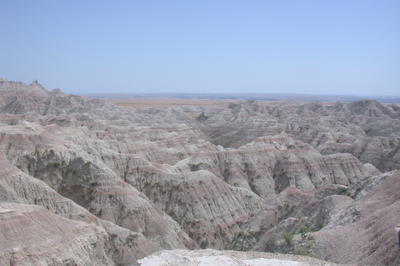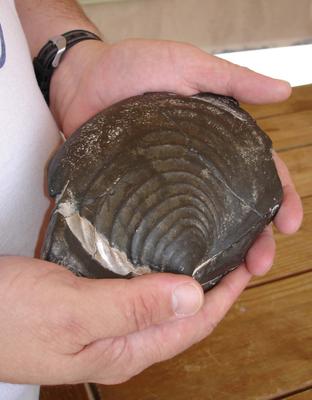Black Hills & Badlands Part 1
We left Brookings early Thursday (7/21) for the 320 mile trip to the Badlands. We got in around 12:15 local (Mtn) time. After lunch at the Cedar Pass Lodge we attempted to check into our room at the Badlands Inn. The desk clerk was a youngish cross between Crispin Glover and Norman Bates who informed me that I was early. His eerie mien, combined with the stark landscape, the 102 degree heat, and the fact that we appeared to be the only guests (and only people for a couple of miles around) had me looking for Hitchcock' s silhouette.

Badlands Inn after a few more guests checked in.
To kill some time before check in (how American -- I'm in the middle of incredible scenery and I talk about "killing time" -- forgive me -- it was REALLY HOT!) we started a drive down the main loop road. Words essentially fail at describing the Badlands, at least for me, but here's architect Frank Lloyd Wright in 1935:
“I’ve been around the world a lot, but was totally unprepared for the revelation called the Dakota Bad Lands….what I saw gave me an indescribable sense of mysterious elsewhere – a distant architecture, ethereal……an endless supernatural world more spiritual than earth but created out of it.”




The first of the above Badlands views is mine, the bottom three are Genna's photographs.
We came across one overlook that had a shelter. As luck would have it a fossil talk was just getting started so we hopped out of the car.
Turns out that the Badlands was under water at one time - part of the Western Interior Seaway. 
So that means there were a lot of sea creatures where we were now standing on rather arid land. And many of those sea critters had the good fortune to become fossilized about 30 to 35 million years ago. Here's a really old clam. And here's another critter with the Mother of Pearl still intact and quite beautiful.
And here's another critter with the Mother of Pearl still intact and quite beautiful. 
Since we're on the topic of fossils, I'll go ahead and jump to the next morning's activity -- checking out the Big Pig Dig at the Badlands. From the National Park Service's brochure on the subject:
"The site’s name, the Pig Dig, comes from that first exposed fossil, originally thought to be the remains of an ancient pig-like mammal called Archaeotherium. It was later identified as a Subhyracodon, a hornless rhinoceros, but the name “Big Pig Dig”stuck. Rhinoceroses are found today in Africa and Asia but smaller versions once lived in the Badlands. Archaeotherium has been found at the site, as well as multiple specimens of ancient horses and deer-like creatures. The horses found are three toed and about the size of a small dog. The tiny Leptomeryx resembles a deer standing only a foot high. More than 10,000 bones have been excavated from the site for research purposes.Why so many animals in one small place? Scientists believe that the area was once a spring-fed watering hole, similar to the large watering areas used by African game today. As the climate began to change to semi-arid, the creatures had to travel longer and longer distances to find water. Some perished as they fought to survive after being mired in the soft sediments. Opportunistic animals were drawn to feed on the dead carcasses. Archaeotherium was a scavenger, feeding on both plants and flesh. Theselarge creatures trampled the site, deeply imbedding some bones and breaking upskeletons. Taphonomy is the study of how fossils are formed and preserved. Taphonomists working at the Pig Dig study the position and condition of bones at the site. These scientists attempt to interpret the activities of animals and try to puzzle out the conditions under which death occurred."
All the work is going under a shelter that is about 20' x 40', which is occasionally repositioned as they exhaust the fossil supply in one spot and move to different parts of the ancient watering hole, finding the edges of it as they go. The park intern told us that several tourists ask how so many animals happened to come to the shelter....the consequence of a population, a majority of which doesn't believe in evolution.
A taphonomist contemplating his day's work.
When a fossil or fossil fragments (the more likely scenario) is encountered, the diggers meticulously work to create a plaster cast to remove the section where it can be taken to the lab for further work in controlled conditions. They dig gingerly underneath the section to create a plaster jacket like this:

And here's some fossils that were recovered from the dig:


And some present day life...




<< Home